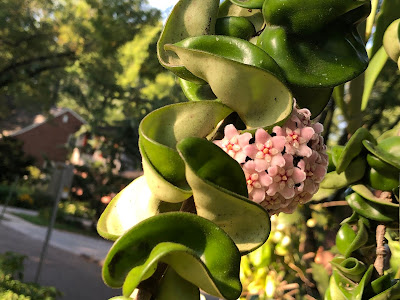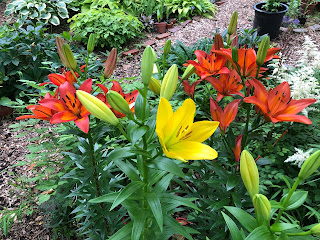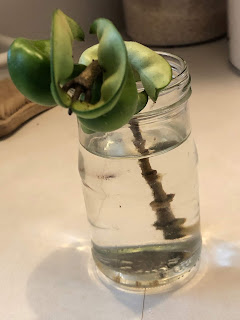Welcome to Week #10. We have come a long way.
It is now February.
In fact today is Ground Hog Day.
What an interesting word, 'persist'.
"Continuing in a firm course of action despite difficulty, opposition, or failure".
It is that kind of world.
Ground Hog Day?
But do not be afraid.
The sun came out yesterday, and with any luck it will be sunny and 40 today.
Who cares about that old rodent's shadow?
6 more weeks of winter? If winter is all gone in 6 weeks, I guess I will take that. That will be mid March.
The sun can help in so many ways.
Yesterday there was the appearance of that wonderful thing, known as "melting."
You could see it, hear it, and practically smell it.
One nice thing about this time of year is watching the snow go away.
Of course we may get to watch it disappear multiple times.
Whatever.
We shall persist.
We shall support those who do persist.
Let us talk flowers.
In last week's contest the easy winner was the Pink Poppy.
I thought after the first 20 votes it might be close. But no.
The Poppy had a clear lead after the first day, and was never threatened.
Here is your winner one more time.
What a glorious trip as you look down into the depths.
Last week I do not think I showed you a closeup of the center of this flower.
Here that is.
Here are the final votes from last week:
Pink Poppy 19
Pink Lupine 7
Japanese Iris 11
Cactus Flower 6
Red Zinnia 4
We had a total of 47 votes. That was the most this year. Way to go, group.
Now let's get to 50 one week.
Call friends. Have your kids vote. There are no preconditions.
Week #10
I have another great group of pictures this week. In a somewhat unusual occurrence, there are no pictures from either April or May. I do strive for diversity.
#1 Fall crocus
October 20, 2019

Crocuses can bloom in the Fall. When they do bloom at that time, they sparkle all by themselves.
This might be a saffron crocus, but I kind of do not think so.
I have lost many labels over time. Actually I do not have many labels for plants that are not there more than half the time. For example I do not label my daffodils for example.
There are two species we are talking about. They are both referred to as fall crocuses.
There is the genus 'crocus'.
The best know species in this genus is Crocus sativus.
Within that species is the saffron crocus.
The spice saffron comes from that crocus. That would be no surprise.
It apparently takes 50-75,000 flowers to make one pound of saffron.
That is why saffron is said to be the most expensive spice.
Imagine the work of picking out all those orange stigmas.
The "stigma" is part of the female reproductive organ of a plant. It, together with the 'style' and the 'ovary,' comprise the 'pistil'.
Don't you now feel smart?
If you want pictures for a better explanation, look it up.
I have always just thought of the crocus as having orange parts.
This particular plant has persisted over the years by the walnut tree in the front yard. It blooms for a long time, maybe over a week.
When it blooms it is so bright, when in the sun.
It is also so small.
It survives frosts and appears, despite all those leaves that want to cover it up.
There are many other fall crocuses.
I do not have as many as I would like.
There is also the entire genus 'Colchicum'.
Trying to give you more education is just going to have to wait for another time.
I can tell you one thing about fall crocuses of both genera.
You can purchase them in July and they will bloom that fall.
But do not dilly dally about making that purchase. I often resolve to order a big group. By the time I have waited a few weeks. they are sold out.
Particularly the colchicum have much foliage in the spring. That at least allows you to remember where they are.
Without that recollection of place I am apt to plant something right on top of them.
#2 Hardy Hibiscus Starry Starry Night
September 14, 2019
That was not a typo in the name. For whatever reason it is called Starry Starry Night.
What a nice name.
I welcomed this hardy hibiscus to the garden this September. I have to say it was an impulse purchase. I forget why I went to the garden center at that time. Maybe it was in search of the elusive pansy. For some reason there were no pansies for sale this last fall. I kept looking for them. (I should just stop talking about pansies and talk about this plant.)
This wonderful plant was at the front of display. (See picture in the bonus section.) Let me list the features that drew me to this plant.
First was the wonderful big pink flowers.
At the store they always have an incredible number of buds.
Then there were the almost black leaves.
Finally there was the fact that it would bloom in September.
The last hardy hibiscus in the garden had died a few years ago.
So I bought the plant. Actually I think I took the picture, came home, found a space for it, and went back to get it.
I moved a daylily and in it went. It will get about 2/3 of a day of sun. It is right out there where everyone could see it.
Each September when you drive around town you will see these wonderful perennial hibiscus on display.
A nearby HyVee drug store has some great big ones in their parking lot, where they have been for years. Sometimes they will get to be 5 feet tall.
The label listed the plant as Hibuscus moscheutos. It is hardy to -30 degrees. Wow.
#3 Hoya-the Hindu Rope plant
July 31, 2019

Hoyas.
One can get obsessed with hoyas.
With this flower you can see why.
This one is called the Hindu Rope Plant.
It is hoya carnosa compacta.
It has twisted shinny leaves that grows as a vine (hence the term 'rope'.)
I find it interesting that it twists more as it gets older.
The pictures from 6 years ago show a plant that was not nearly as twisted as the mature plant today.
It is an ideal hanging plant.
Caution - it does have to come inside in the winter.
It apparently is a succulent.
What is a succulent?
I looked up the definition.
"Tender, juicy and tasty"
Wait - there must be some other definition.
OK - the next definition was "a succulent plant."
I am not sure I was making progress.
The word comes from a Latin word meaning juicy.
ok wikipedia- do your thing
https://en.wikipedia.org/wiki/Succulent_plant
It is a thick-leafed plant, where the thickness lets it retain water.
So it has to do with survival where there is not much water.
OK-that makes sense.
More education
Here is the wikipedia for hoyas
https://en.wikipedia.org/wiki/Hoya
They are in the apocynaceae family. (aka Dogbane- I don't make this stuff up.)
Hoya is the genus.
If you think of it as a succulent, you can master its care.
Do not over-water. In the winter let it go mostly dormant.
I water mine about once a month.
The plant must be big enough to bloom. My plant is mature. It has hanging branches that are maybe 5 feet long. This plant started blooming for me a while back. How long is that? Well I think it was 6-8 years ago. I will check the photo library where there are the over 31,000 pictures. Unfortunately there is no sortable function. Maybe in a few years. And yes I do have a backup.
So I checked. I have a picture of the rope hoya blooming from 2013. My estimate was about right. However neither Julia or I can remember where it came from originally.
Plant care:
https://plantcaretoday.com/hindu-rope-plant.html
Pictures of the world of hoyas:
https://www.pinterest.com/pin/424464333627099885/?lp=true
I do not know if you can access this or not. But let us try.
I am propagating some of my hoyas this winter. I am starting some from cuttings. I am also trying to start some from leaf cuttings. Both seems to be working.
#4 Asiatic Lily Fiamma
(June 28, 2019)

Fiamma also joined the garden in 2019. It is an Asiatic lily. Asiatic lilies are some of the first lilium to bloom. (Later are the Orientals and the Trumpets.)
I planted 3 of these bulbs, all together, in the fall of 2018. As with any first time bloomer I did not know what to expect.
I was not disappointed. This summer I bought some more. They will be sprinkled around the garden this coming summer.
There will be a summer. I need to remember that.
I also will have my deer spray ready.
In the bonus section you can see the group.
They were joined after about a week with some more Asiatic lilium that were bright yellow.
#5 Blue Siberian Iris
June 1, 2019

Blue is such a wonderful color in the garden.
It goes so well with everything else.
This is one of my blue Siberian Iris. They bloom after the bearded iris are finished.
I lost the name. It has bloomed in the garden for years. Then again there are many varieties of blue Siberian iris. I am not sure I could tell which is which without a label right there.
One thing I do have is the collection of lost labels. I sometimes get all the lost labels together and try to match them to the picture.
But I can still appreciate the color and the wonderful patterns on the parts that hang down.
Bonus Section
Here is Starry Starry Night, the video.

Here it was, at the nursery.
This is the picture I took home, checking to see if there might be a place where I could put it.
Sometimes I get a plant with a spot in the garden in mind. Sometimes I just get some plants and decide that space will appear.


Here is the Hoya Rope plant this summer, roping down almost 5 feet.

It really is blooming much more now that it is a more mature plant. There were blooms all up and down the stem.

This is the different hoya plant I brought back from my mother's kitchen. I brought back the two plants she had hanging over her kitchen sink for decades. It seemed like there were always some flowers when we would visit.
It does not have the tight cluster of the Rope plant.
I liked this picture as the cluster was peeking out.
Hoya rope plant pictures from 2013



The flower in 2013 was the same cluster of many little flowers with many multiples of 5.
These are the colchicum crocuses that bloom for me in September. They have formed big clumps over the year. All these pictures were from 2019. They were taken on September 10, 12 and 14.
I had to move some of the clumps as they were just lost in with the japanese anemones. Those plants tend to get big and do not play well with others.



More Fiamma
These pictures were taken from June 22 to June 28.






Right Now
Here are a few pictures from the Mears Indoor Garden as of February 1.







The last two pictures are hoya cuttings that are starting to root.
I should have little hoya plants in the springtime.
Julia's recipe
Kale, as a side dish

Here are the ingredients: a bunch of kale (cleaned and chopped it came to about 4 cups); 1-1/2 cups sliced onion; 1 tablespoon smushed garlic; 1 teaspoon red pepper flakes; 1 teaspoon cumin seeds; 1 teaspoon kosher salt; 2 tablespoons olive oil; 2 tablespoons rice wine vinegar (or cider vinegar or white wine vinegar); and a little bit of water (maybe 1 tablespoon).

I started by de-stemming the kale. You can either pull the leaves off the stems or fold each leaf in half and slice the stem out. But no stems, as they are too coarse.
Next I washed and salad-spun the leaves. Then I sliced them across into maybe 1/2 to 3/4" slices.
Then I peeled the onion, cut it in half through the root end and sliced each half into half-moon slices. I think I used part of a second onion to get up to 1-1/2 cups.

I smushed the garlic and put it in a little bowl with the red pepper flakes, cumin seeds and salt.
I heated the olive oil in a big skillet and added the onions. I cooked the onions over medium high heat for about 5 minutes, then added the contents of the little bowl and cooked everything for another minute or two.

Next I added al of the kale and stirred the stuff around.

After a minute or two, I added the vinegar. The skillet seemed a bit dry so I also added 1 tablespoon of water.

I put a lid on the skillet and turned the heat down to low. I think it cooked for another 10 minutes or so.

Here it is, in the bowl, looking dark and mysterious. We served it with baked chicken and baked sweet potato, followed by green salad. So the kale was the only assertive flavor on the table. It's tasty, easy and nutritious.
A few words on variations. I used red/purple kale. We like how it looks. You can use whatever kind of kale you like - green, lacinto, red. Probably collards or mustard greens for that matter.
I seasoned my dish with red pepper flakes, cumin seed and vinegar. You could use grated ginger, sesame seeds and tamari. Or some kind of hot chile or chipotle with oregano and lime juice. I would always use onion and garlic. But the rest is really wide open for experimentation or for using what is on hand, which is often the same thing.
Odds and ends
It is not necessary to spell it out.
Flowers are good. The garden is a good diversion.
But it is still winter and sometimes good times seem far away.
I fear for the world and the country my grandson will inherit.
We must continue our work.
We must persist.
That is a good word.
But the meaning of the word does not say anything about the outcome.
Maybe it does not matter.
Until next week.
Philip




3 comments:
Inspired by this week's garden blog, I think I'll try to get a Starry Starry Night hibiscus. I have just the spot for it, assuming it will work in my part of Florida (zone 9+). My guess is that it's named after the Van Gogh painting "Starry Starry Night," which has big round spiral bursts of color like that hibiscus (though yellow, not pink).
I may also try a rope hoya--love those tiny waxy flowers. Oddly, it's been cold here lately--down into the lower 40s, very unseasonable for this climate. But if the hoya is in a hanging basket, I can bring it in when cold threatens (I'm having to do that now with some of my more tender succulents).
In gardening, as in other things, we will persist!
about kale: we treat it very similarly, but don't braise--just keep stirring over heat with plenty of olive oil, then we toss with pasta (usually capellini, since that's what Peter will eat if we give him some before the kale-toss). The kale is a little crunchy on the edges, the pasta soft, then some Parmesan grated on top...dinner.
Pat- A reader writes with this information about the name Starry Starry Night.
"Starry starry night" are the opening words to a song by Don McLean composed in 1970. He was inspired while reading a biography of Vincent van Gogh. He named the song Vincent, and it is representative of van Gogh's painting "The Starry Night." https://genius.com/Don-mclean-vincent-starry-starry-night-lyrics.
Thank you Marilyn.
If you have your choice of hoyas I think you should try for one with the exotic colors- like red.
Post a Comment